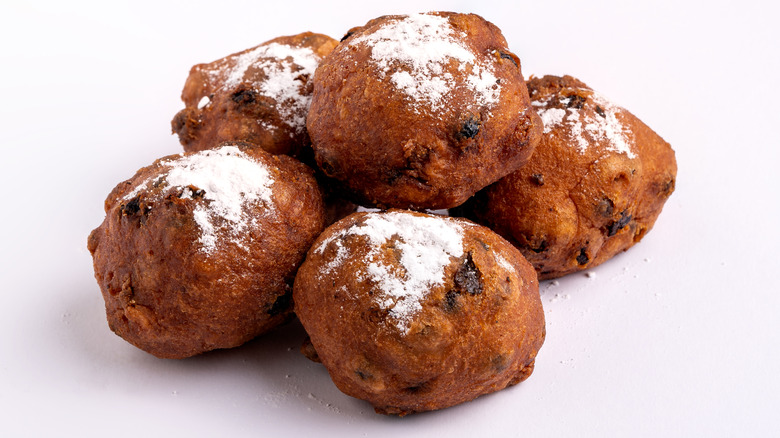The Dutch Immigrant Origins Of Donuts
Donuts first came to Manhattan when the island was still called New Amsterdam. The Big Apple wouldn't officially become "New York" until 1664 when Dutch Governor Peter Stuyvesant surrendered to English naval squadron leader Colonel Richard Nicolls, who led the triumphant mission under the Duke of York. But, while New York City served as the important backdrop for this historical moment in dessertdom, we're more focused on the real star of the show: The donuts. When Dutch immigrants first began moving to New York in troves during the 17th and 18th centuries, donuts came with them.
These proto-donuts were called olie koeken or olykoeks, meaning "oil cakes" in Dutch. Other sources find the treat referred to as oliebollen ("oil balls"). By whatever name, these fried beauties were humble cake balls stuffed with fruit or nut filling and fried in pork fat until golden brown. A recipe for "oliekoecken" can be found in a Dutch cookbook from the 17th century, detailing a simple, almost utilitarian ball of leavened yeast dotted with dried fruit. All they took to make were a few staple baking ingredients and a kettle of boiling oil, and at the time, their now-signature ring shape had yet to be invented.
Punching a hole in the confectionery scene
In his 1809 "A History of New York, from the Beginning of the World to the End of the Dutch Dynasty," prolific American writer Washington Irving immortalized the donut as "balls of sweetened dough, fried in hog's fat, and called doughnuts, or olykoeks — a delicious kind of cake, at present scarce known in this city, except in genuine Dutch families," per BBC. Historians agree that Irving's record is the first time that the Dutch treat was referred to as a "donut" in writing, ostensibly inspired by the contemporary British fashion of calling small round pastries "nuts."
Alternate lore suggests that the name "donut" originated on a New England ship, crafted by the hands of the captain's mother Elizabeth Gregory. In a stroke of thrifty ingenuity, Gregory stuffed the center of some doughy pastries she made for the crew with hazelnuts or walnuts to ensure that the center would cook all the way through, hence literal "doughnuts." Her son, ship captain Hansen Gregory, is credited with being the first to punch a hole through the center of the donut in 1847, changing the shape of the beloved treat forever. This simple maneuver effectively increased the exposed surface area of the dough, making it possible for the hot oil to cook the donut all the way through, with no nutty filling needed.
A multicultural classic takes the world stage
By the time the 1900s rolled around, American foodies had caught a scorching case of donut fever and the dessert was here to stay. Donuts had become so firmly ingrained in American culture that by World War I, a legion of volunteer "Doughnut Lassies" was traveling overseas to the trenches of battle in France to serve American troops a taste of home. The automatic donut-making machine was invented in the 1920s by Russian immigrant Adolph Levitt, a contraption described in lusty, Penthouse-esque detail by a 1931 "New Yorker" article: "Doughnuts float dreamily through a grease canal in a glass-enclosed machine, walk dreamily up a moving ramp, and tumble dreamily into an outgoing basket," via Smithsonian Magazine.
The 1934 World's Fair in Chicago gave donuts the stage for their literal and proverbial global debut, where they were championed as the "food hit of the Century of Progress," fueling the future. Krispy Kreme opened a brick-and-mortar shop in 1937, and the first Dunkin' Donuts store opened in 1950. From "The Simpsons" fame to coffee shop immortality, the modern donut may be an American institution, but foodies everywhere have the Dutch to thank for their morning glaze — except for crullers, which are French, but that's a story for another time.


